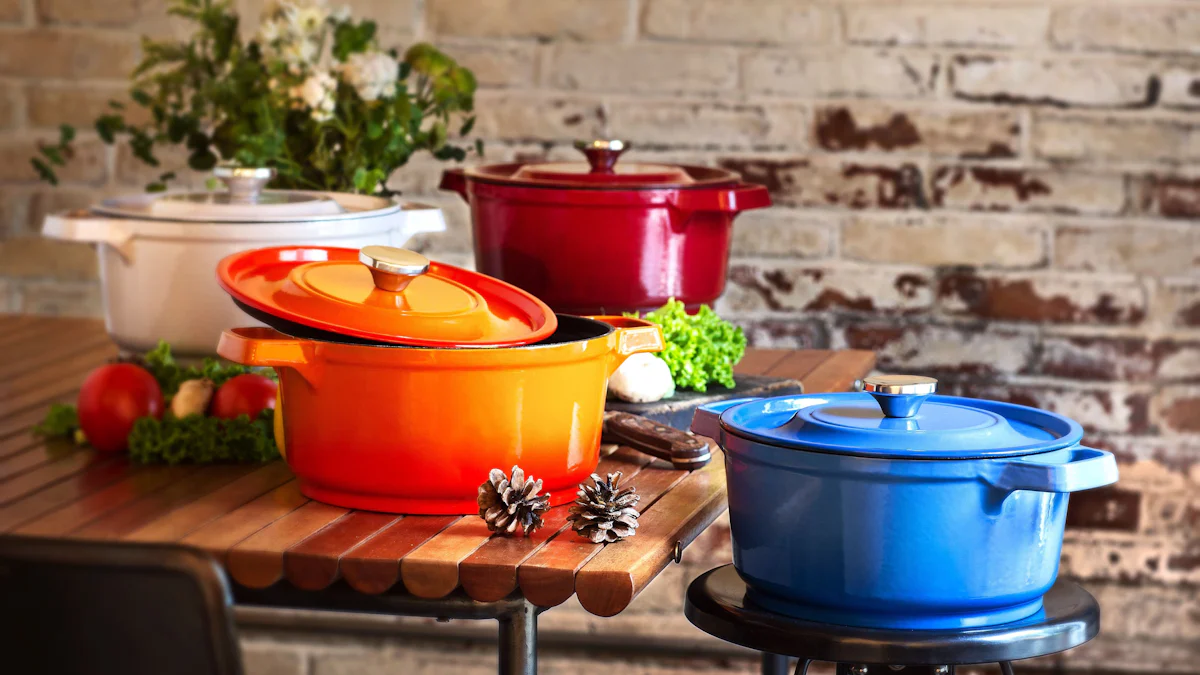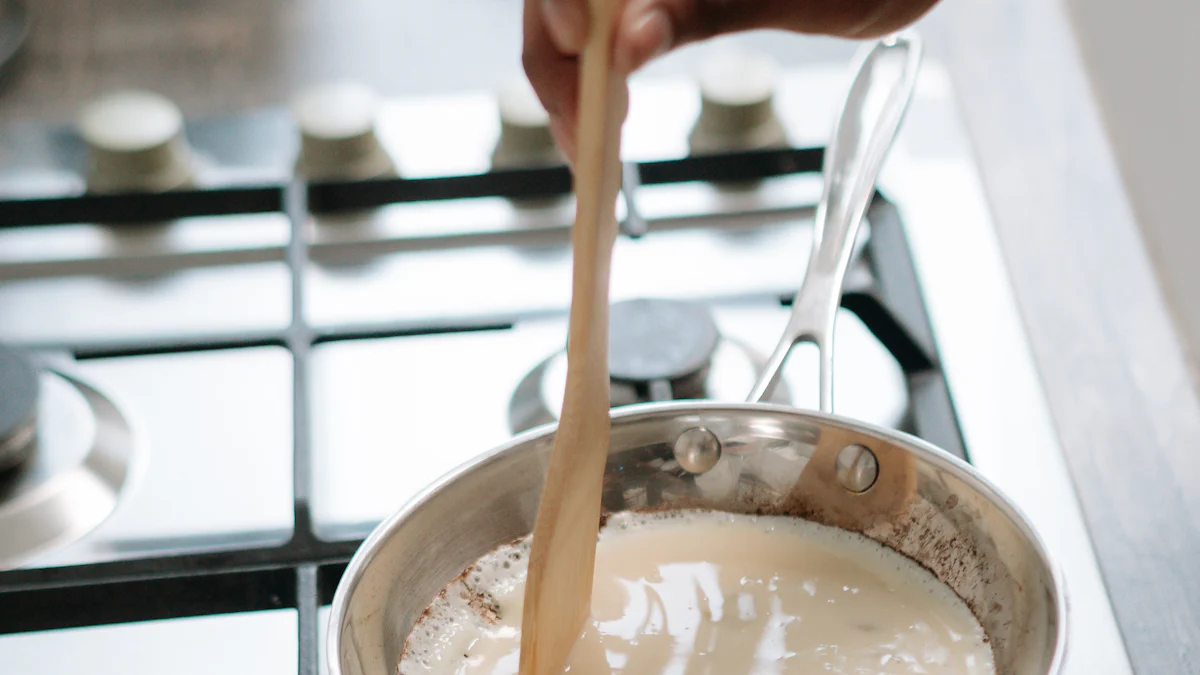Silicone lids offer a convenient solution for covering dishes in the oven. Most of these lids can withstand high temperatures, making them a versatile kitchen tool. You might wonder if they're safe for oven use. The answer is yes, but with a caveat. Always check the manufacturer's guidelines to ensure your silicone lid can handle the heat. Following safety guidelines is crucial to prevent any mishaps. Unlike a glass lid, silicone provides flexibility and ease of use, but you must remain cautious about temperature limits.
Understanding Silicone Lids

What Are Silicone Lids?
Silicone lids have become a staple in many kitchens. You might wonder what makes them so special. Well, let's dive into their material and design.
1. Material and Design
Silicone lids are crafted from food-grade silicone, a flexible and durable material. This silicone can stretch to fit various container sizes, providing a snug seal. The design often includes a smooth surface that makes cleaning a breeze. You can find them in different shapes and colors, adding a touch of fun to your kitchenware.
2. Common Uses
You can use silicone lids for a variety of purposes. They work great for covering bowls, pots, and pans. They help keep food fresh by creating an airtight seal. Unlike a glass lid, silicone lids are lightweight and easy to store. You can even use them in the microwave or freezer, making them incredibly versatile.
Understanding the heat resistance of silicone is crucial when using these lids in the oven. Let's explore their general properties and temperature tolerance.
Understanding the heat resistance of silicone is crucial when using these lids in the oven. Let's explore their general properties and temperature tolerance.
3. General Properties
Silicone is known for its ability to withstand extreme temperatures. It doesn't crack or warp easily, which makes it ideal for kitchen use. You can rely on silicone to maintain its shape and flexibility, even when exposed to high heat.
4. Temperature Tolerance
Most silicone lids can handle temperatures up to 425°F. Some can even withstand a range from -76°F to +446°F. This means you can use them for both hot and cold applications. However, always check the manufacturer's guidelines to ensure your lid's specific temperature tolerance. This way, you avoid any mishaps while cooking.
Safety Guidelines
When using silicone lids in the oven, safety should be your top priority. Following these guidelines will help you use them effectively and avoid any potential issues.
1. Checking Manufacturer Specifications
Before you place a silicone lid in the oven, always check the manufacturer's specifications. This step ensures that you're using the product safely.
a. Importance of Reading Labels
Reading labels might seem tedious, but it's crucial. Labels provide essential information about the product's heat tolerance and usage instructions. By taking a moment to read them, you can prevent accidents and ensure that your silicone lid performs as expected.
b. Identifying Oven-Safe Products
Not all silicone lids for cookware are created equal. Some are designed specifically for oven use, while others are not. Look for labels or packaging that clearly state the product is oven-safe. This way, you can confidently use your silicone lid without worrying about it melting or releasing odors.
2. Temperature Limits
Understanding the temperature limits of your silicone lid is vital for safe oven use. Exceeding these limits can lead to damage or even safety hazards.
a. Typical Maximum Temperatures
Most silicone lids can withstand temperatures up to 425°F. However, some may have different limits. Always verify the maximum temperature your specific lid can handle. This information helps you avoid using the lid in conditions that could compromise its integrity.
b. Avoiding Overheating
Overheating can cause silicone lids to warp or emit unpleasant odors. To prevent this, monitor the oven's temperature closely. If you're unsure about the oven's accuracy, consider using an oven thermometer. This simple tool can help you maintain the right temperature and keep your silicone lid in good condition. Remember, a glass lid might offer more heat resistance, but silicone lids provide flexibility and ease of use when used correctly.
Potential Risks
When using silicone lids in the oven, you should be aware of potential risks. Understanding these risks helps you use your silicone lids safely and effectively.
1. Melting and Odours
a. Causes of Melting
Silicone lids can melt if exposed to temperatures beyond their tolerance. This usually happens when you don't check the manufacturer's specifications. Placing a silicone lid too close to a direct heat source, like a broiler, can also cause melting. Always ensure your oven's temperature stays within the safe range for your silicone lid.
b. Preventing Unpleasant Odours
Silicone lids might emit unpleasant odours if they overheat. These odors often result from the breakdown of silicone at high temperatures. To prevent this, avoid exposing your lids to temperatures above their limit. Regularly clean your lids to remove any food residues that might contribute to odors. A clean lid not only smells better but also performs better.
2. Mitigating Risks
a. Proper Usage Techniques
Using silicone lids properly minimizes risks. Always place the lid securely on your dish, ensuring it doesn't touch the oven walls or heating elements. Unlike a glass lid, silicone offers flexibility, so make sure it fits snugly without stretching too much. This practice helps maintain the lid's integrity and prevents damage.
b. Monitoring During Use
Keep an eye on your silicone lids while they're in the oven. Regular monitoring allows you to catch any issues early, like overheating or warping. If you notice any signs of trouble, remove the lid immediately. Consider using an oven thermometer to ensure accurate temperature readings. This simple tool can help you maintain the right conditions for your silicone lids.
Best Practices
When using silicone lids in the oven, following best practices ensures safety and extends the life of your kitchen tools. Let's explore how you can make the most of these versatile lids.
1. Effective Use in the Oven
a. Proper Placement
Place your silicone lid carefully on the dish. Ensure it fits snugly without stretching too much. This prevents the lid from slipping off during cooking. Unlike a glass lid, silicone offers flexibility, so you can adjust it to fit various container sizes. Make sure the lid doesn't touch the oven walls or heating elements. This placement helps maintain its integrity and prevents damage.
b. Avoiding Direct Heat
Keep your silicone lid away from direct heat sources like broilers. Direct heat can cause the lid to warp or melt. Position your dish on a middle rack to avoid excessive heat exposure. If you're using a convection oven, consider reducing the temperature slightly. This adjustment helps protect your silicone lid from overheating.
2. Cleaning and Maintenance
Proper cleaning and maintenance keep your silicone lids in top condition. Let's look at some safe cleaning methods and tips for extending product life.
a. Safe Cleaning Methods
Clean your silicone lids with mild soap and warm water. Avoid using abrasive cleaners or scouring pads, as they can damage the surface. You can also place them in the dishwasher for a thorough clean. Ensure the lids are completely dry before storing them. This practice prevents mold and maintains their flexibility.
b. Extending Product Life
Store your silicone lids flat or rolled up to save space. Avoid folding them, as this can cause creases. Regularly inspect your lids for signs of wear or damage. Replace them if you notice any cracks or warping. By taking these steps, you ensure your silicone lids last longer and perform better.
Comparing Silicone Lids with Glass Lids

When you're deciding between silicone lids and glass lids, it's important to consider their unique features. Both have their strengths, but they serve different purposes in the kitchen. Let's break down their differences to help you make an informed choice.
1. Heat Resistance
Silicone lids are known for their flexibility and ability to withstand a wide range of temperatures. Most can handle up to 425°F, making them suitable for many oven tasks. However, you should always check the manufacturer's guidelines to ensure your specific lid's heat tolerance. On the other hand, a glass lid typically offers higher heat resistance. You can use it at higher temperatures without worrying about melting or warping. This makes glass lids ideal for dishes that require prolonged cooking at high heat.
2. Versatility and Use Cases
Silicone lids shine in terms of versatility. You can use them in the oven, microwave, freezer, and even the dishwasher. Their flexible nature allows them to fit various container sizes, providing a snug seal that keeps food fresh. They're lightweight and easy to store, making them a convenient choice for everyday use. In contrast, a glass lid is more rigid and heavier. While it may not offer the same flexibility, it provides a clear view of your food as it cooks. This feature is particularly useful when you need to monitor the cooking process without lifting the lid. Glass lids are also great for stovetop cooking, where you might need to keep an eye on simmering sauces or boiling soups.
In summary, both silicone and glass lids have their place in the kitchen. If you value flexibility and ease of use, silicone lids are a great choice. But if you need something that can handle higher temperatures and offers visibility, a glass lid might be the better option. Consider your cooking habits and preferences to decide which type of lid suits your needs best.
Using silicone lids in the oven can be safe and effective when you follow key safety tips. Always check the manufacturer's specifications to ensure your lid can handle the heat. This simple step helps you avoid mishaps and keeps your kitchen experience smooth. Silicone lids offer flexibility and versatility, making them a valuable addition to your cooking tools. They help retain moisture and heat, enhancing your culinary creations. By understanding their benefits and limitations, you can confidently use silicone lids to elevate your cooking game.
Post time: Dec-16-2024


